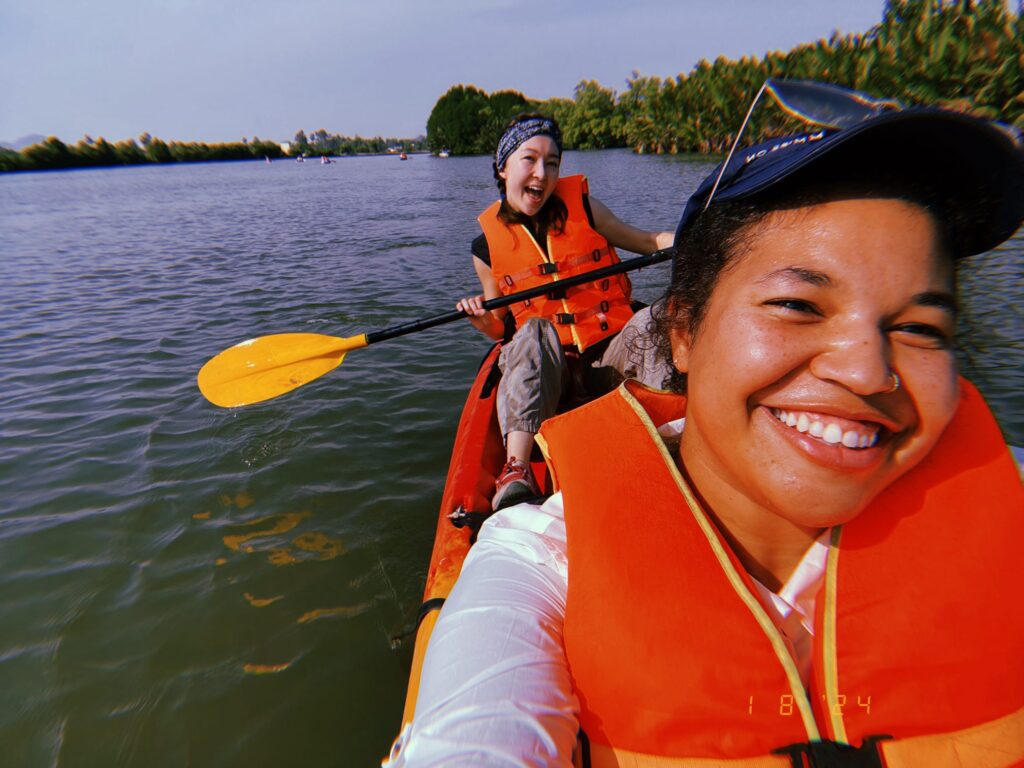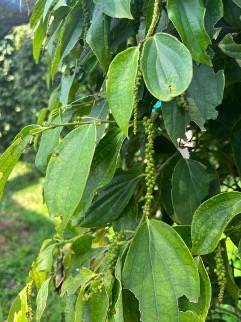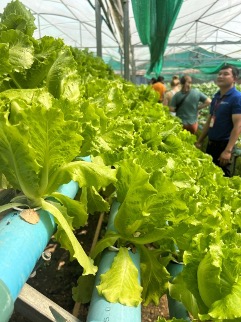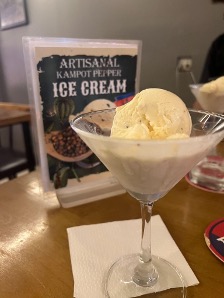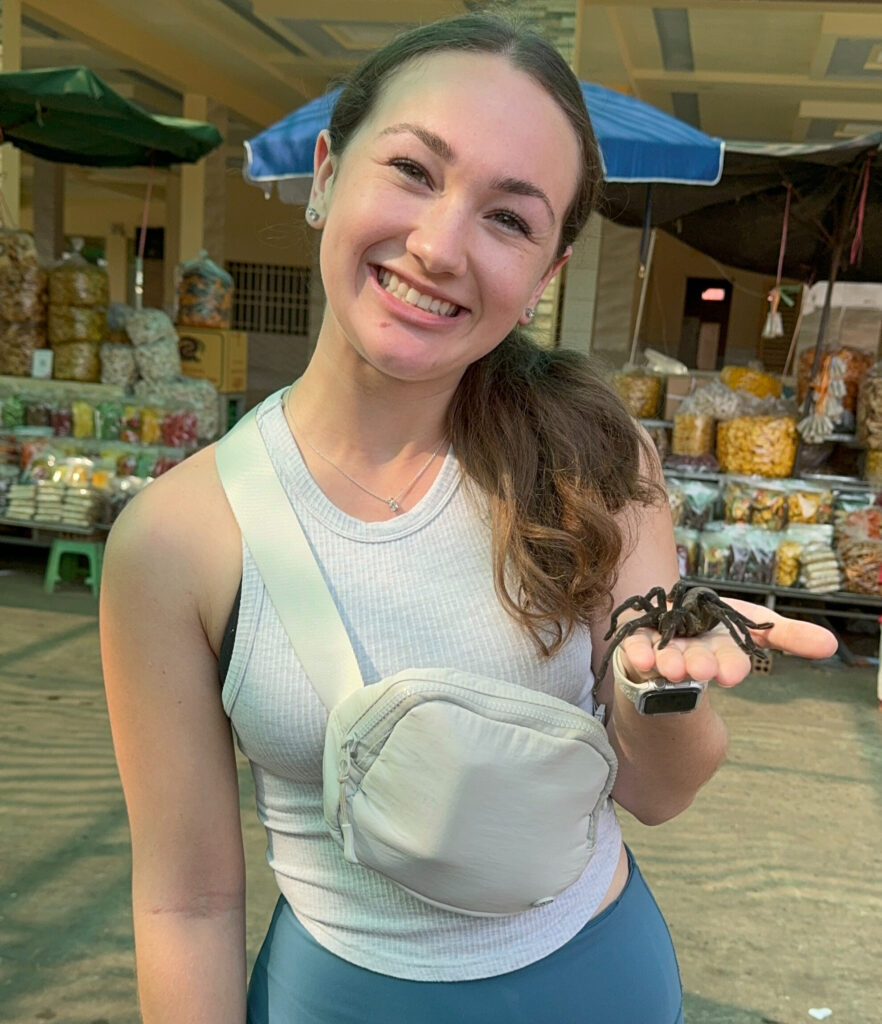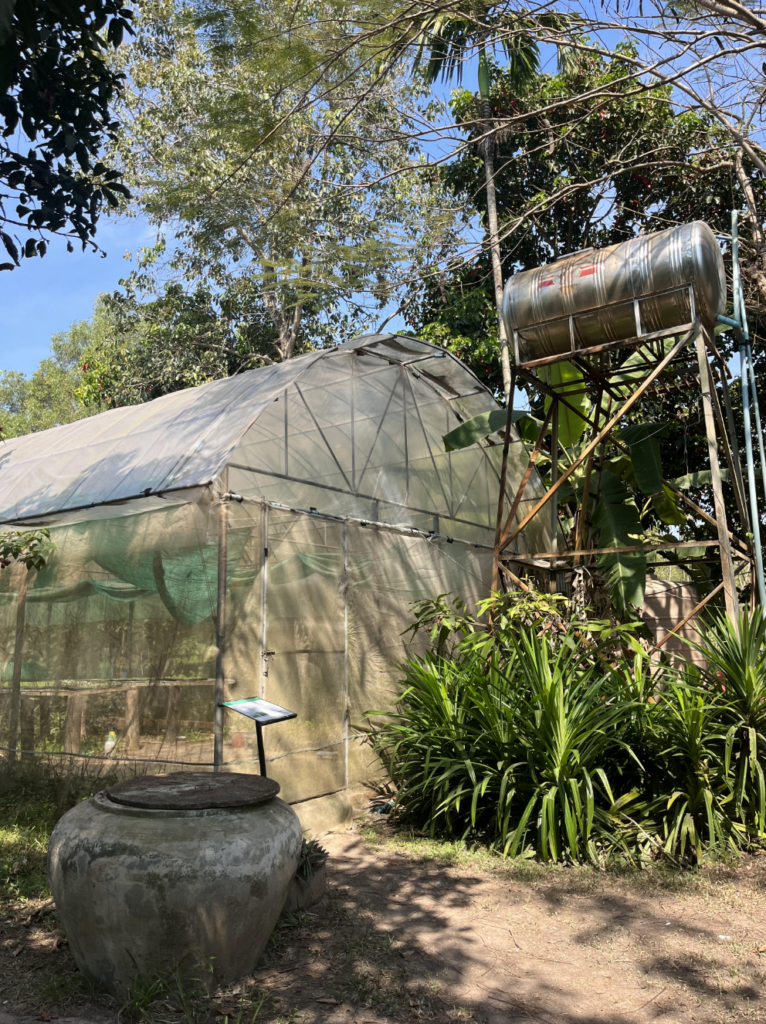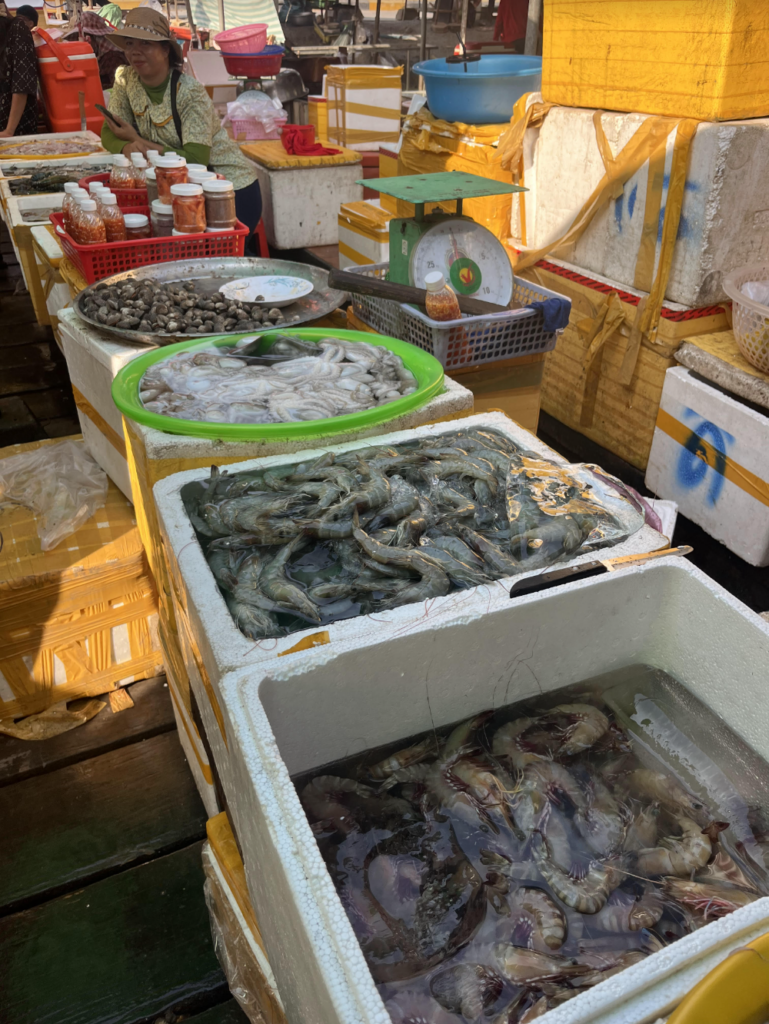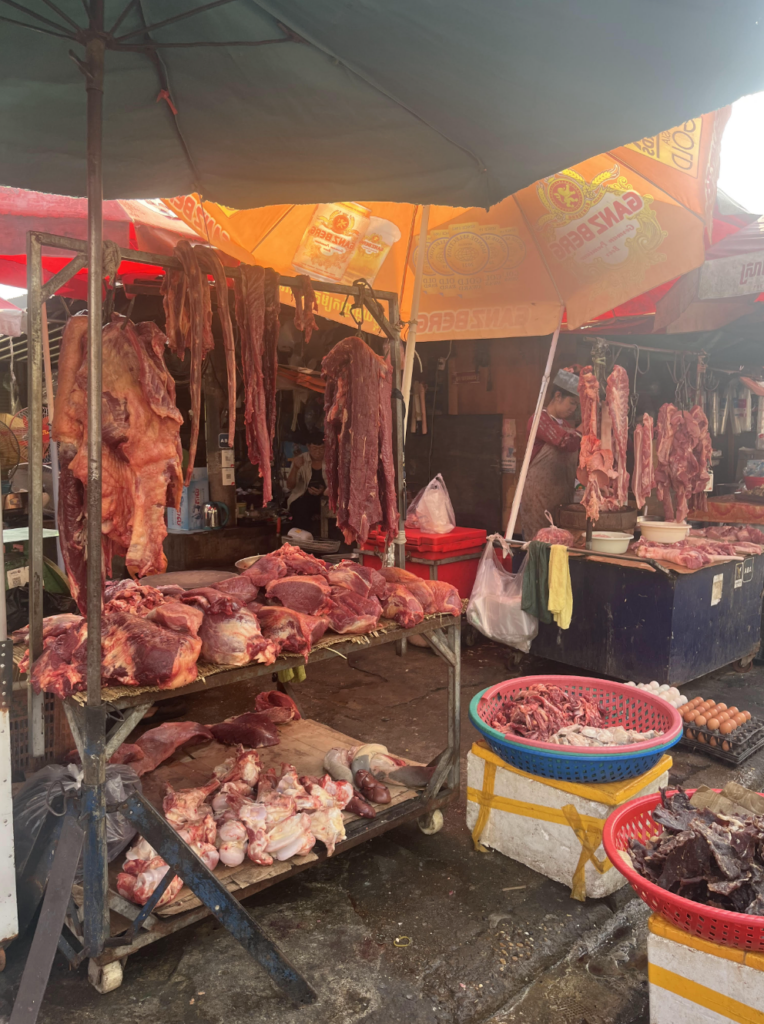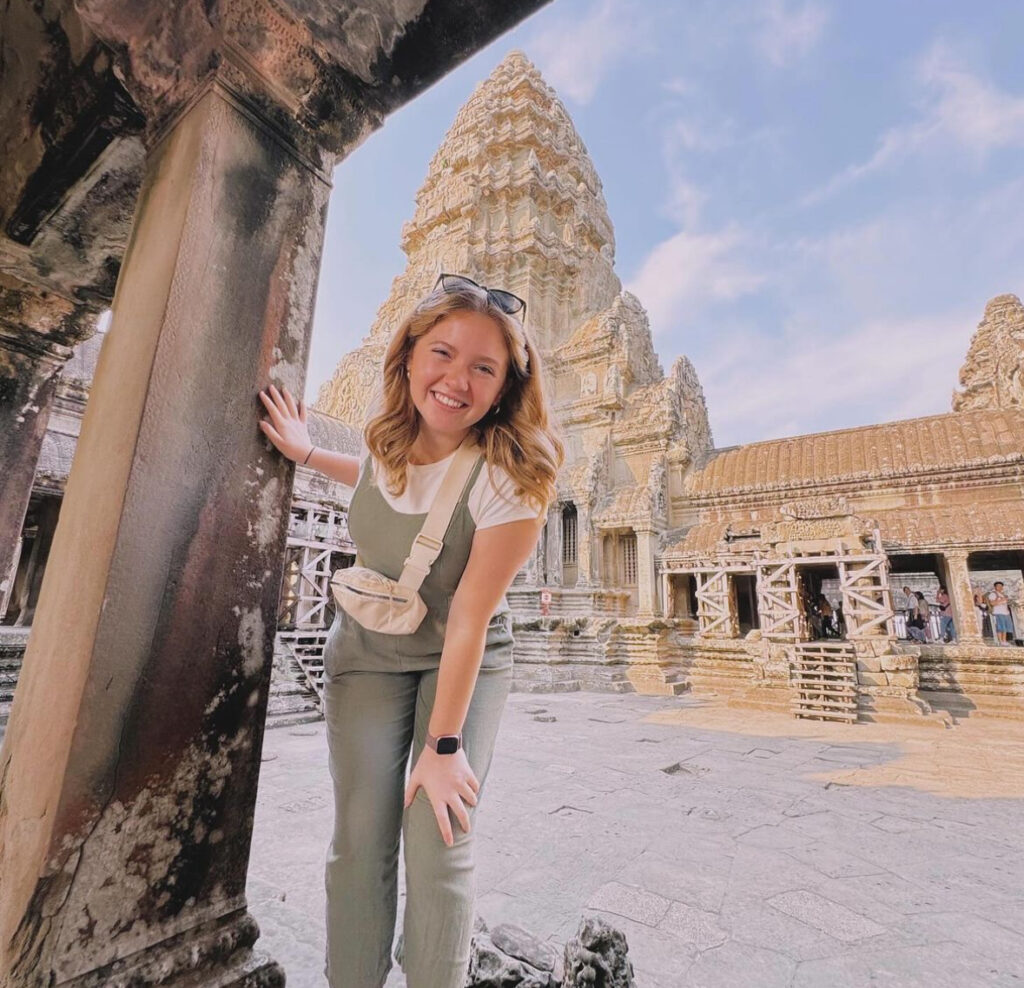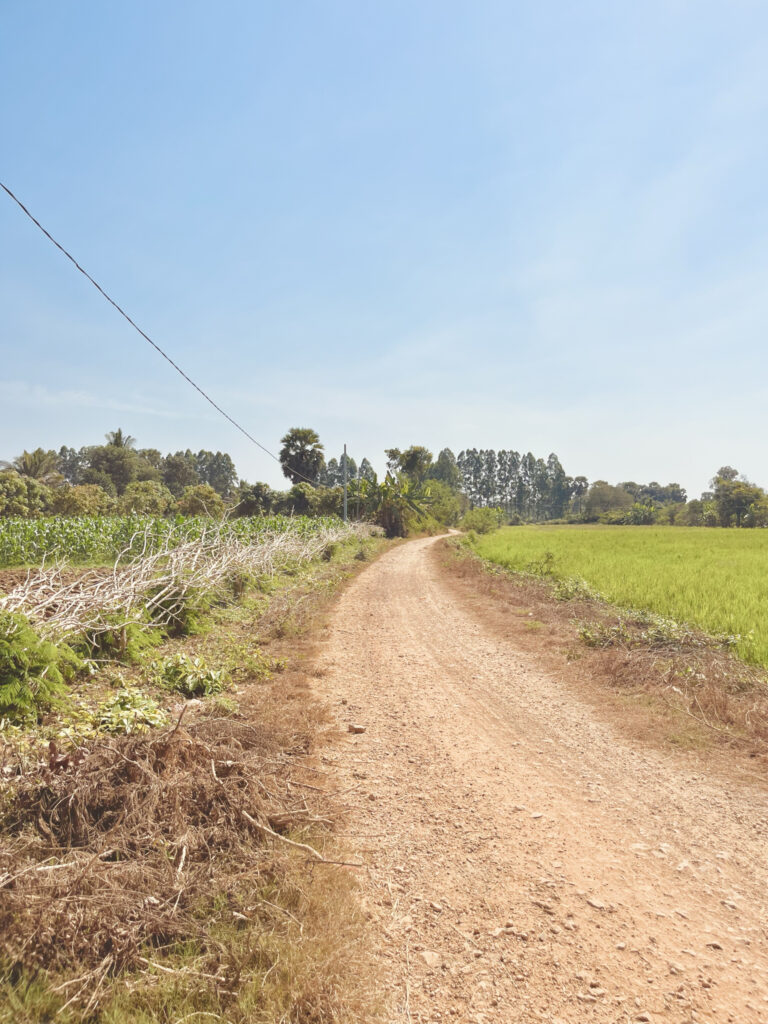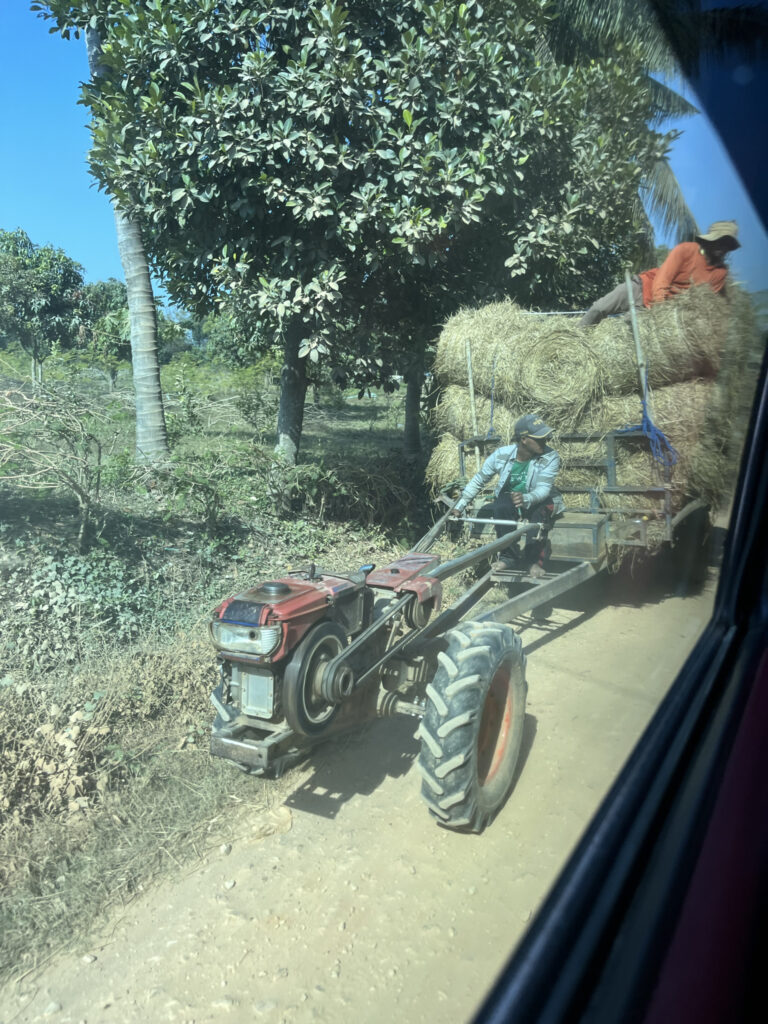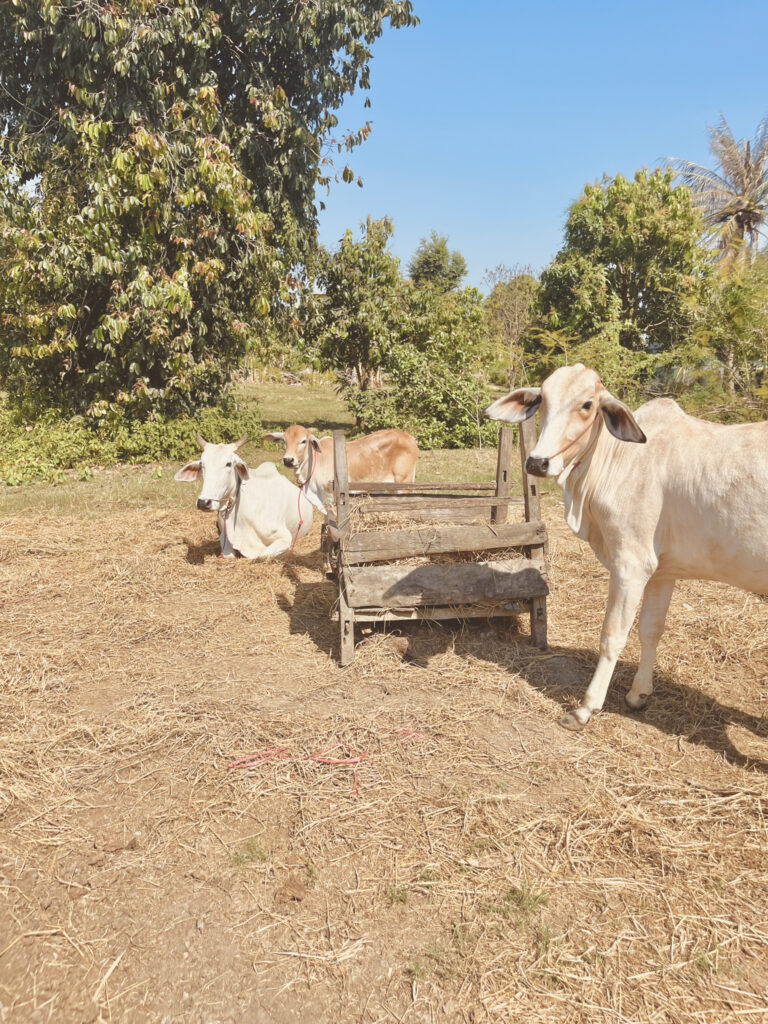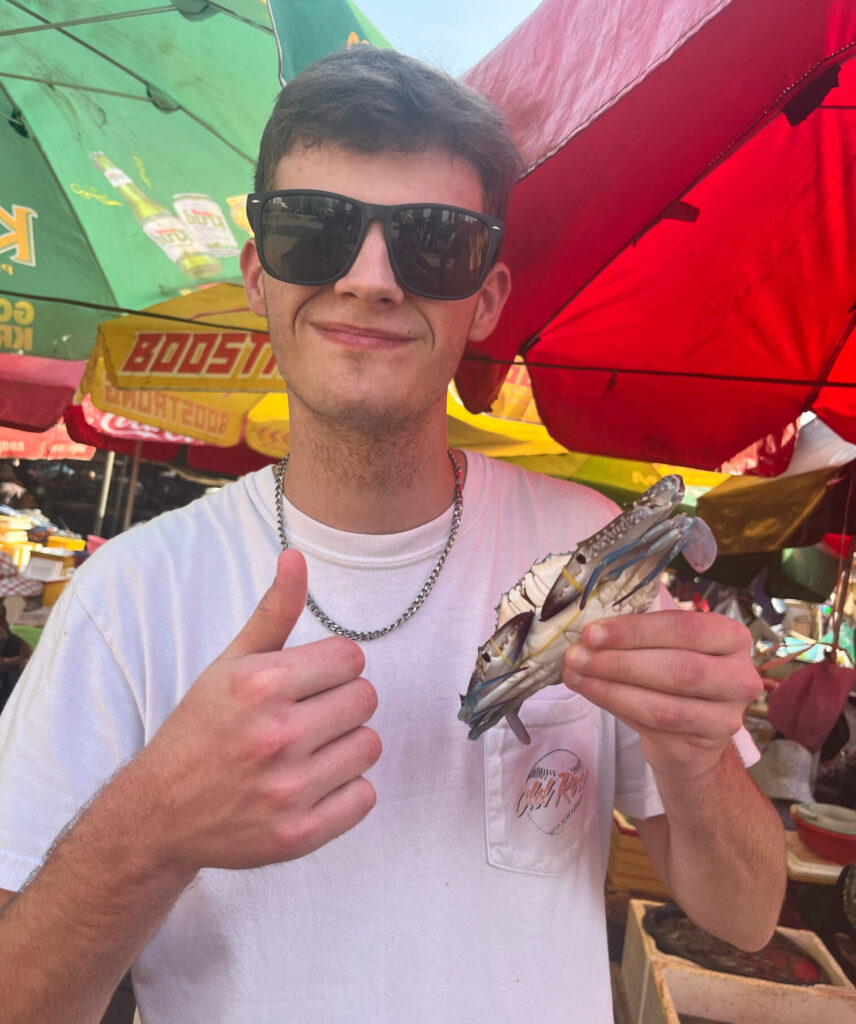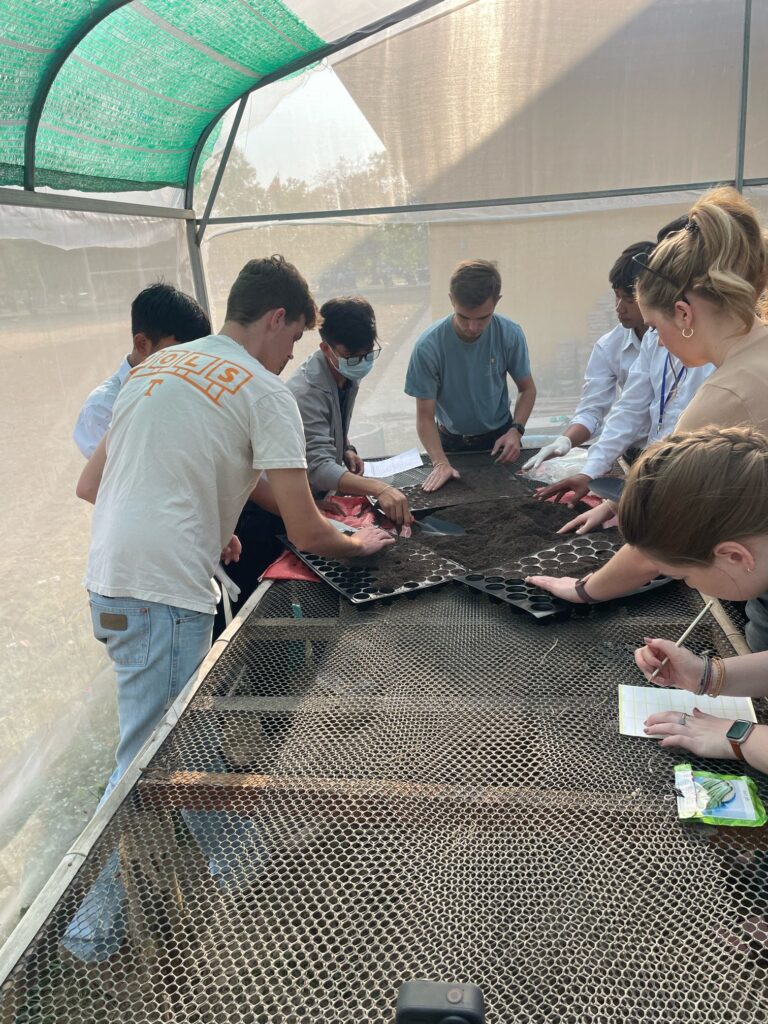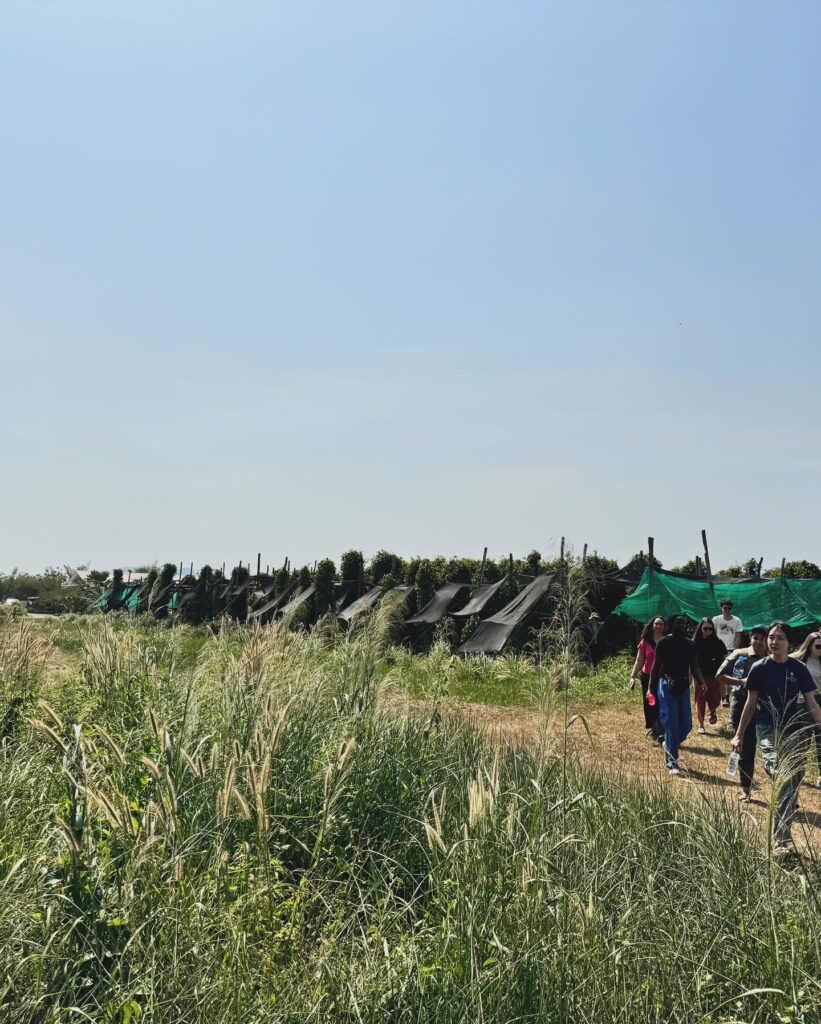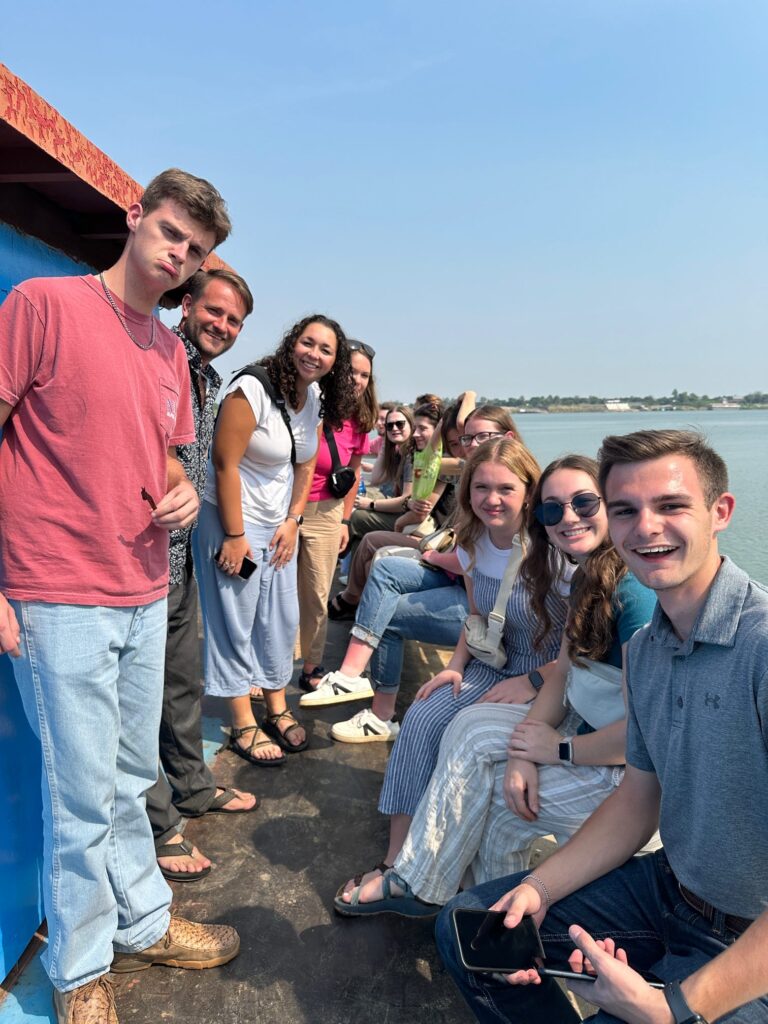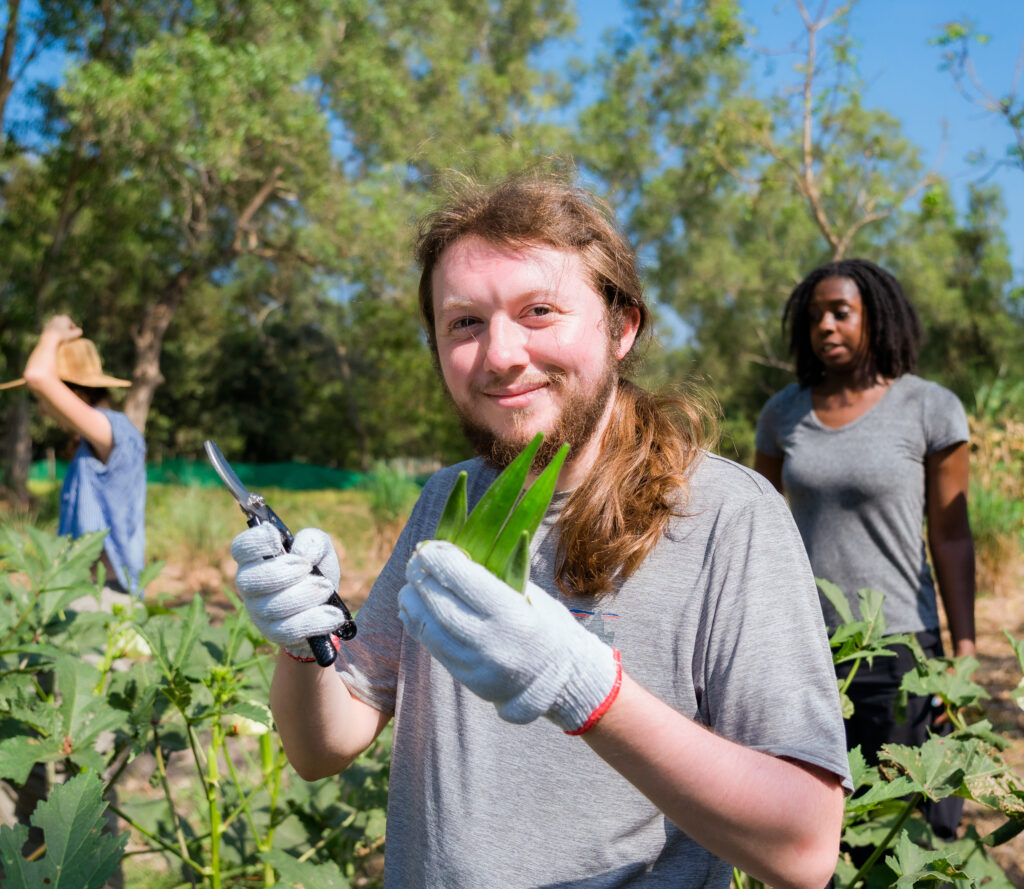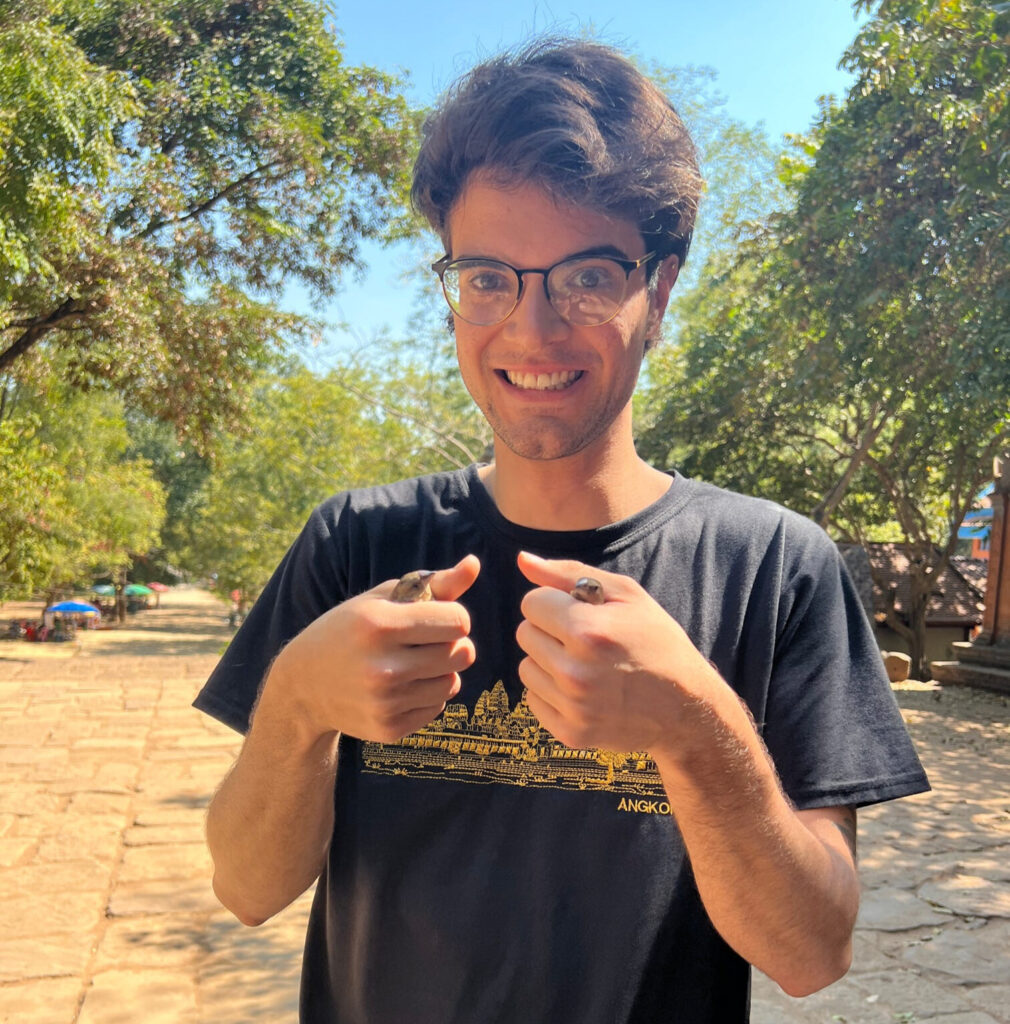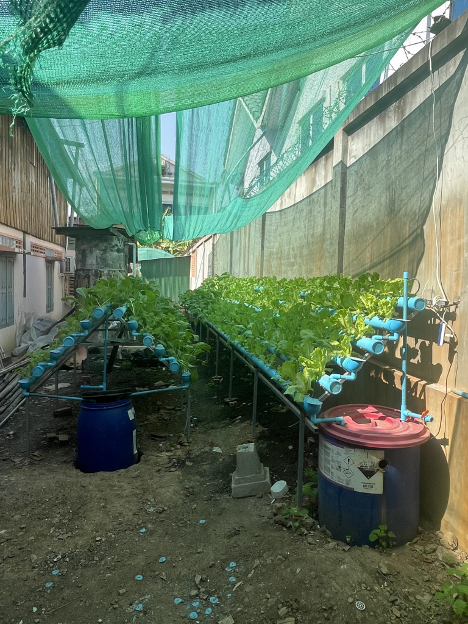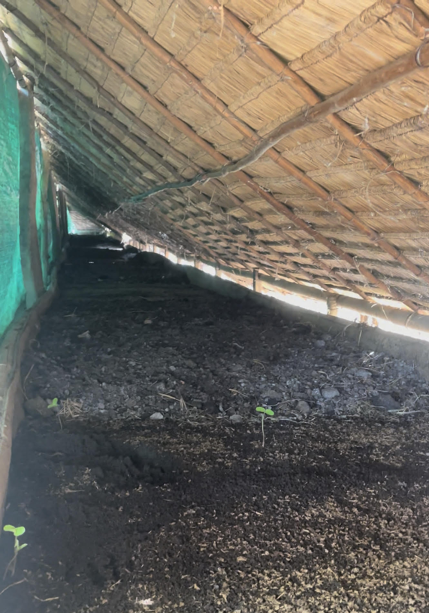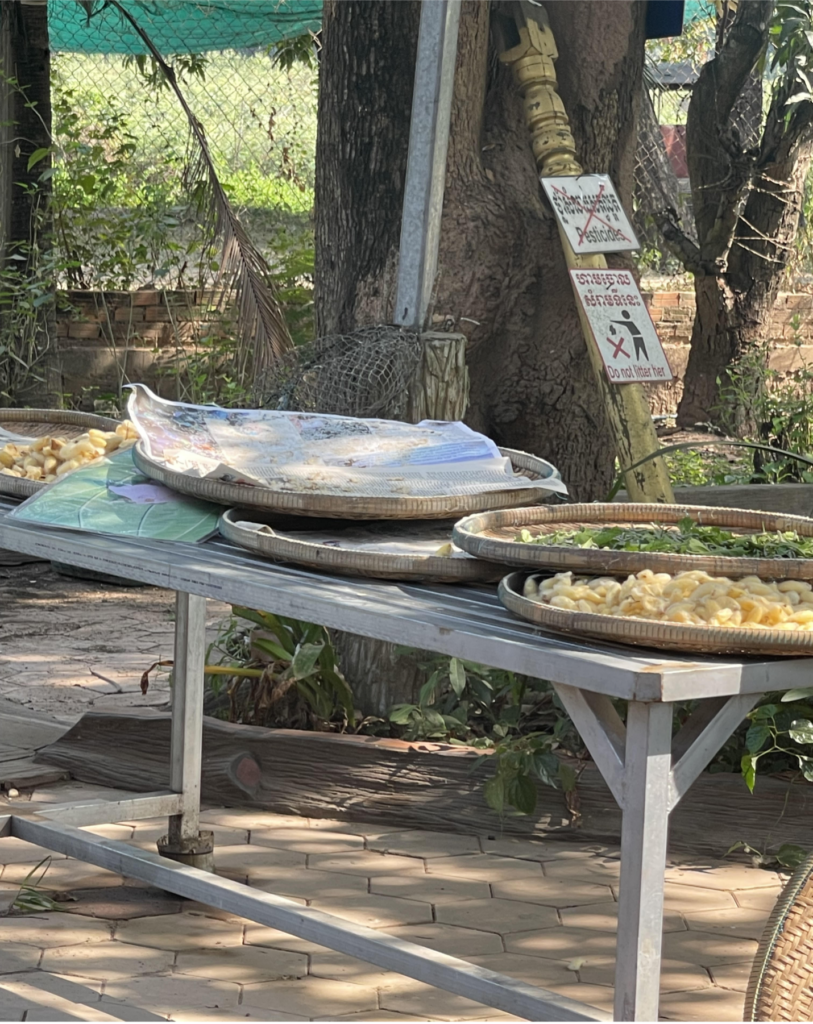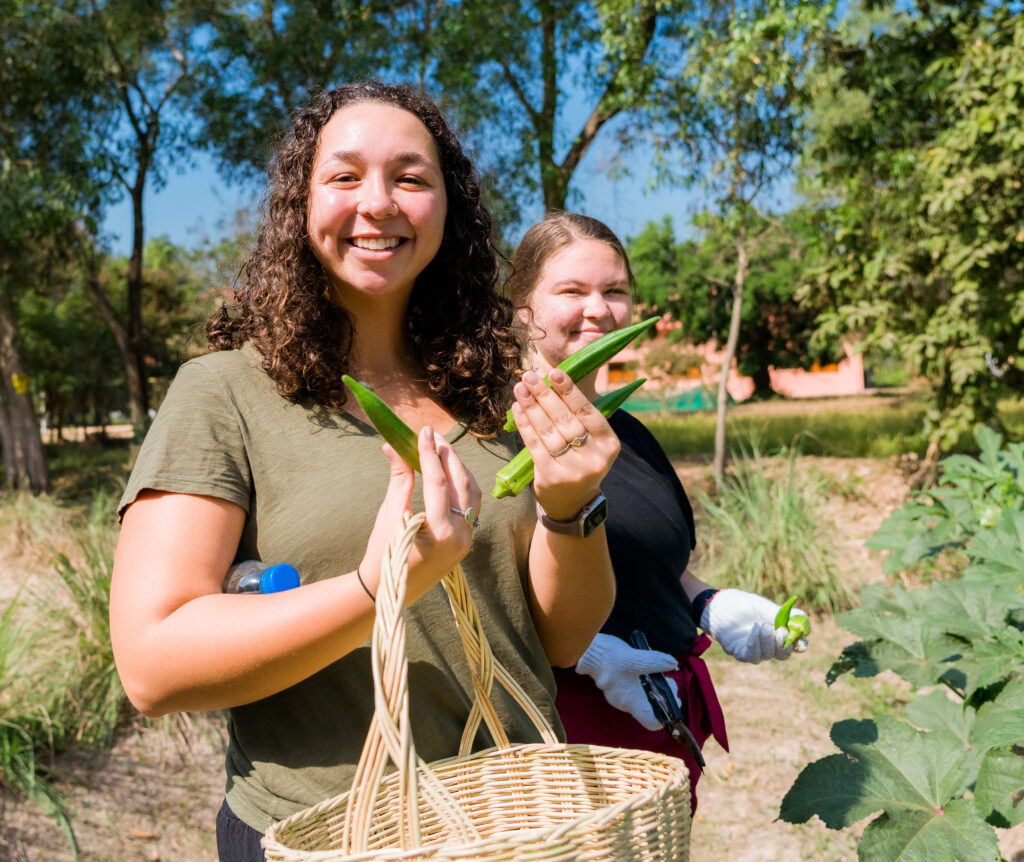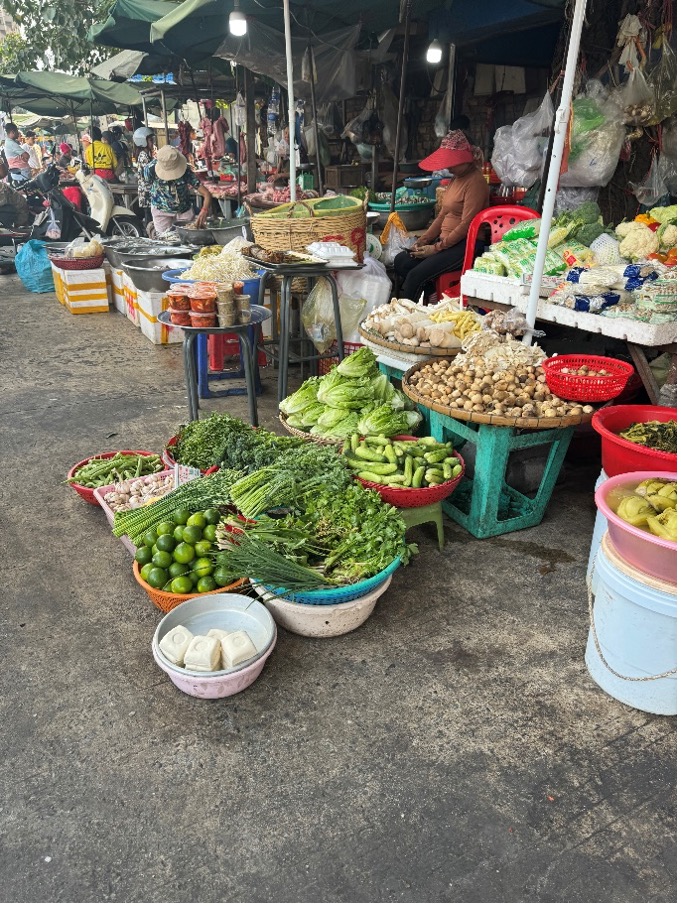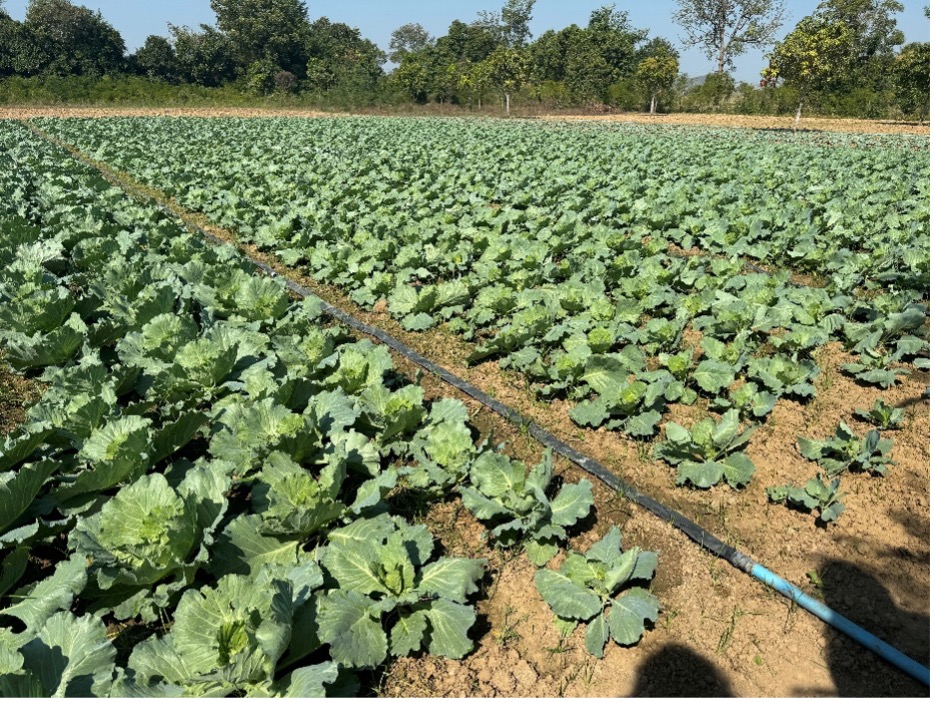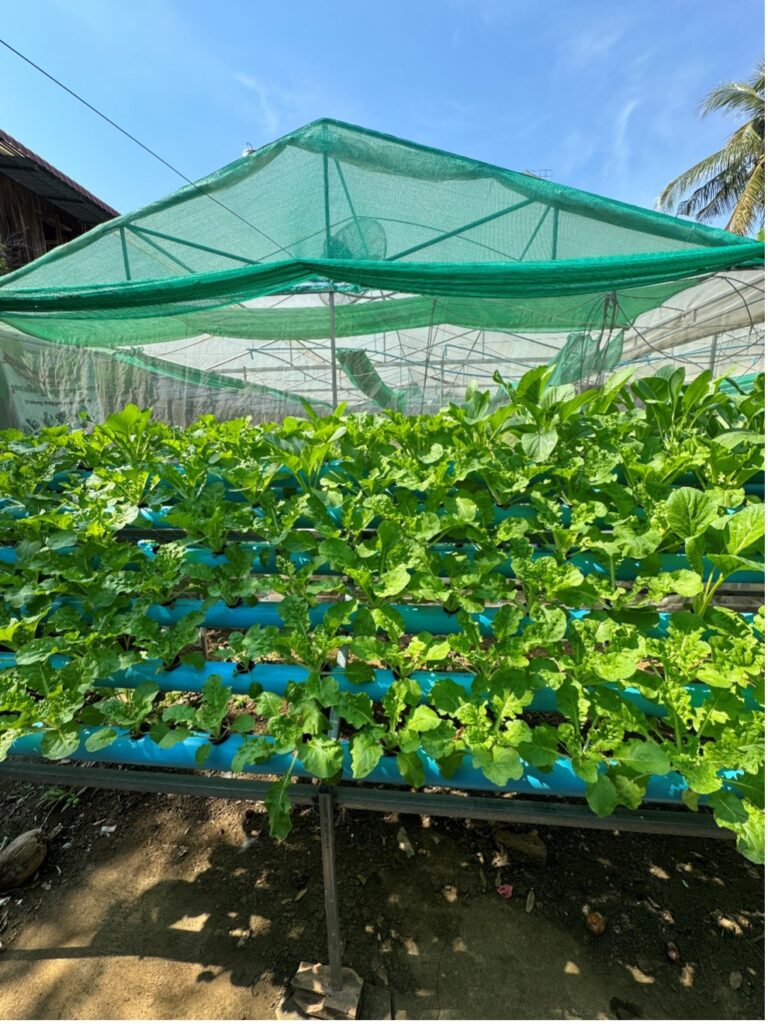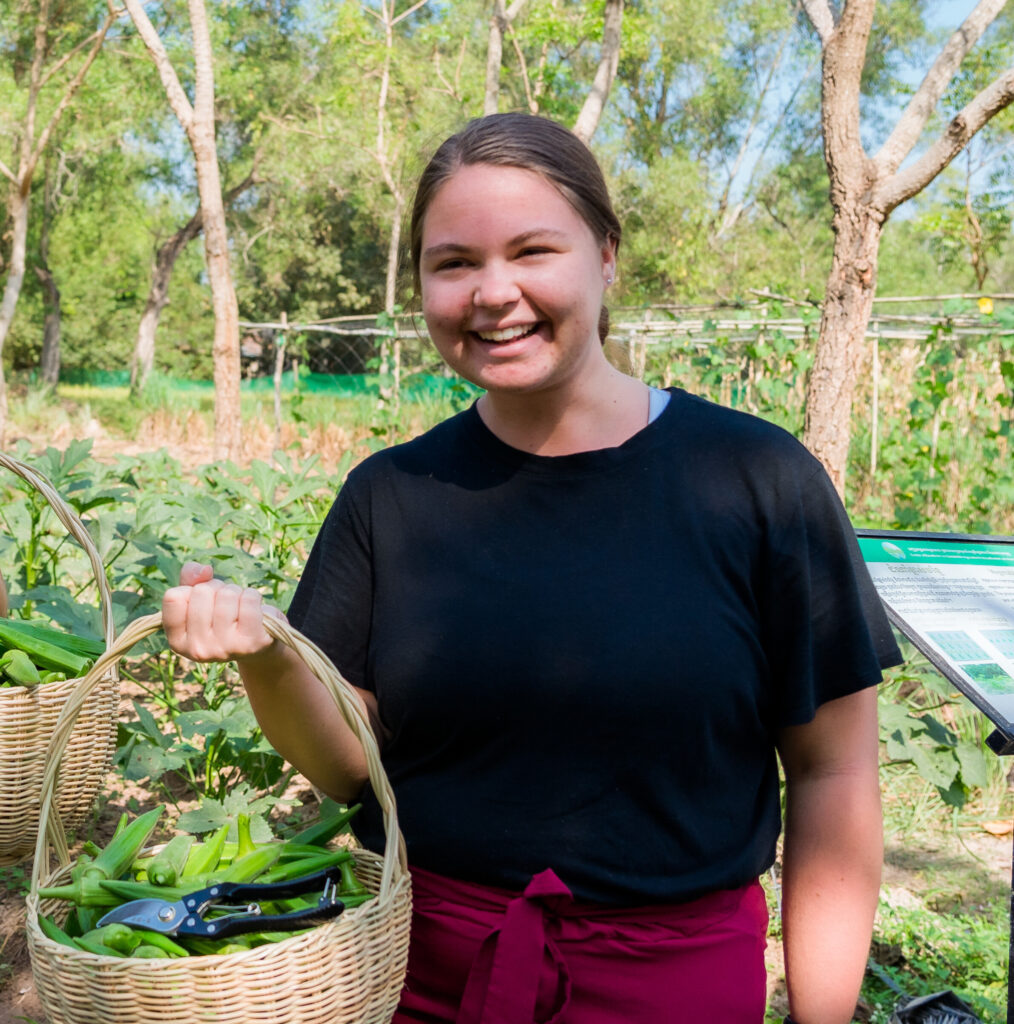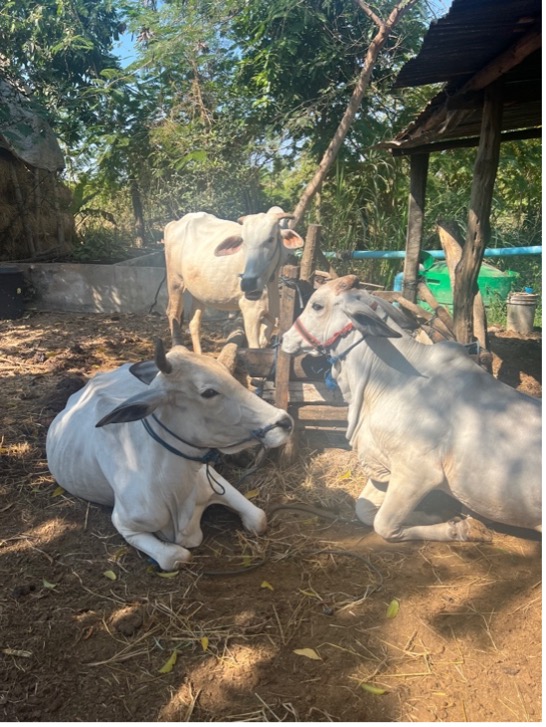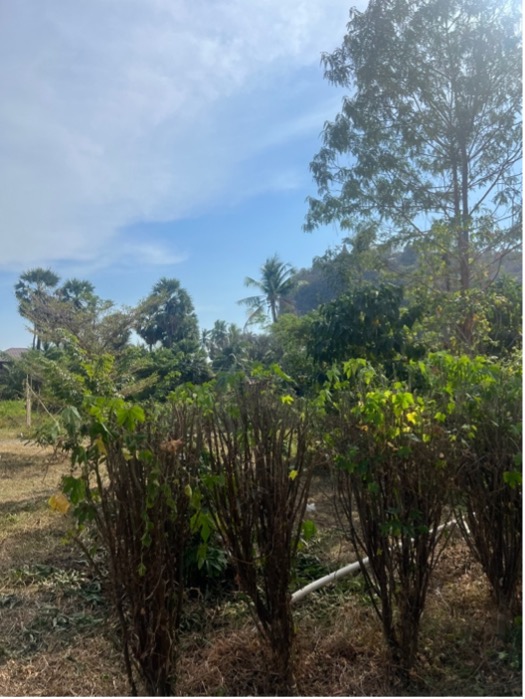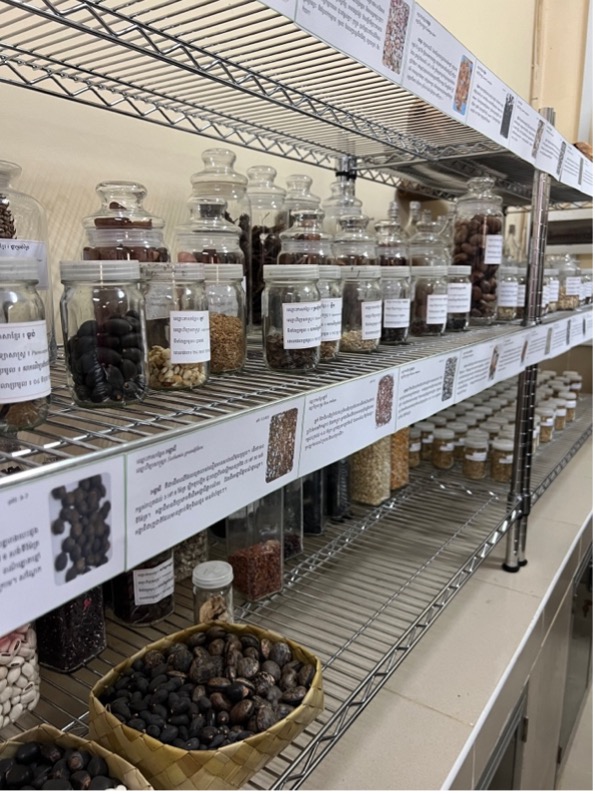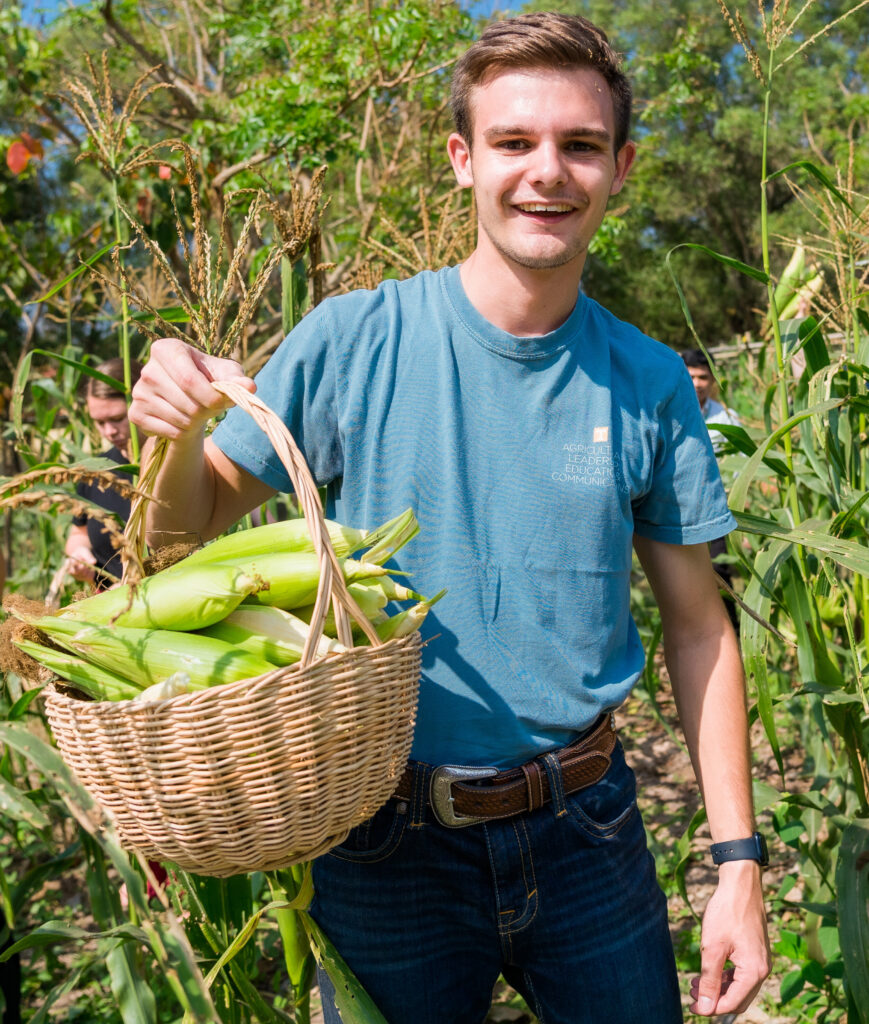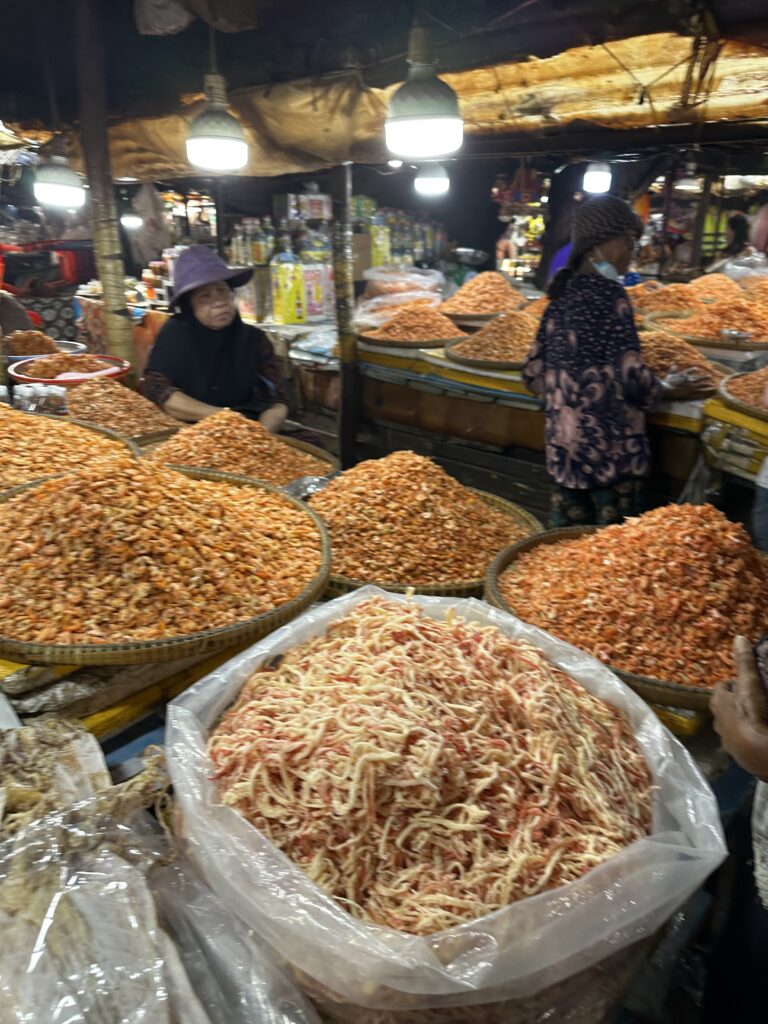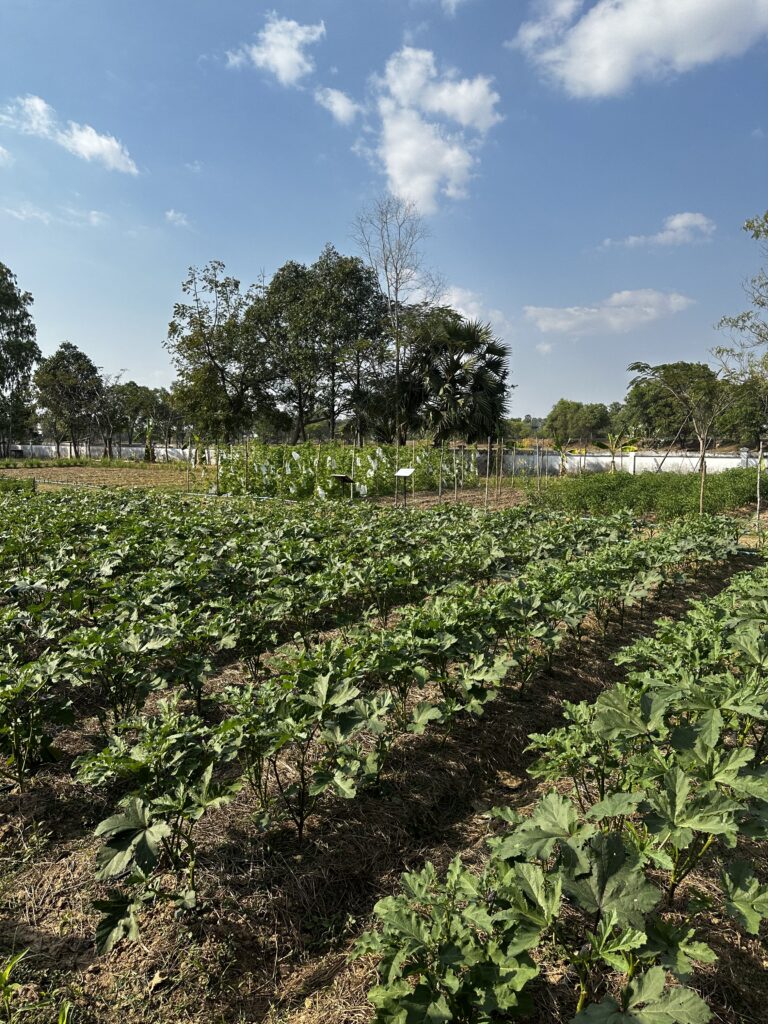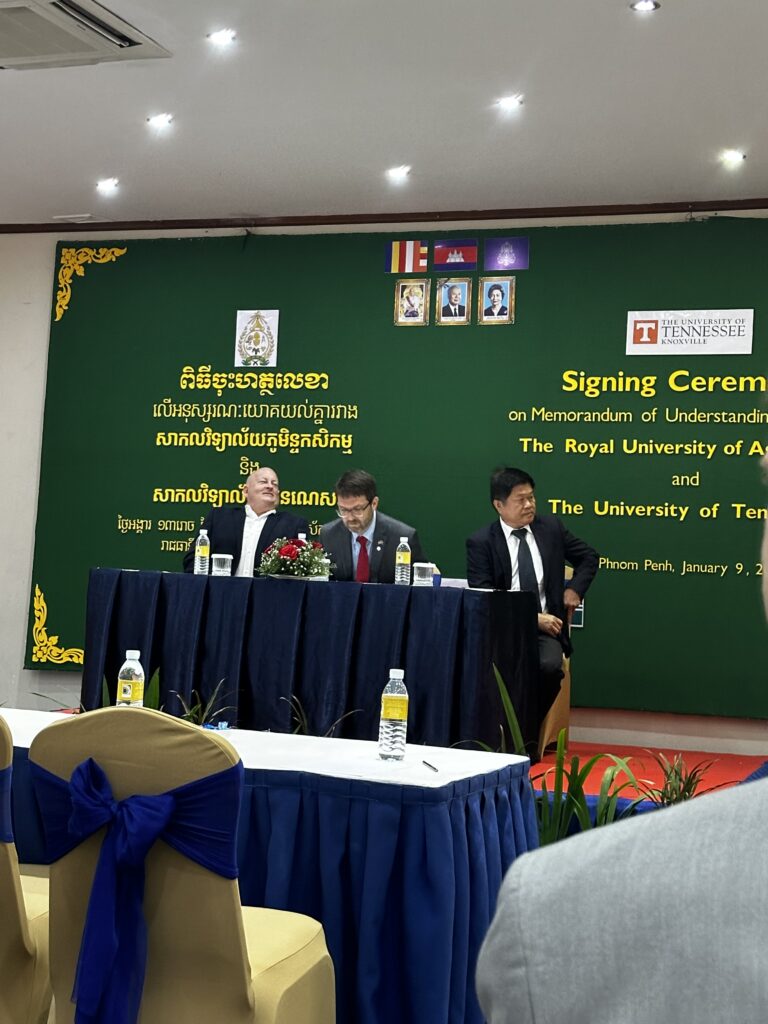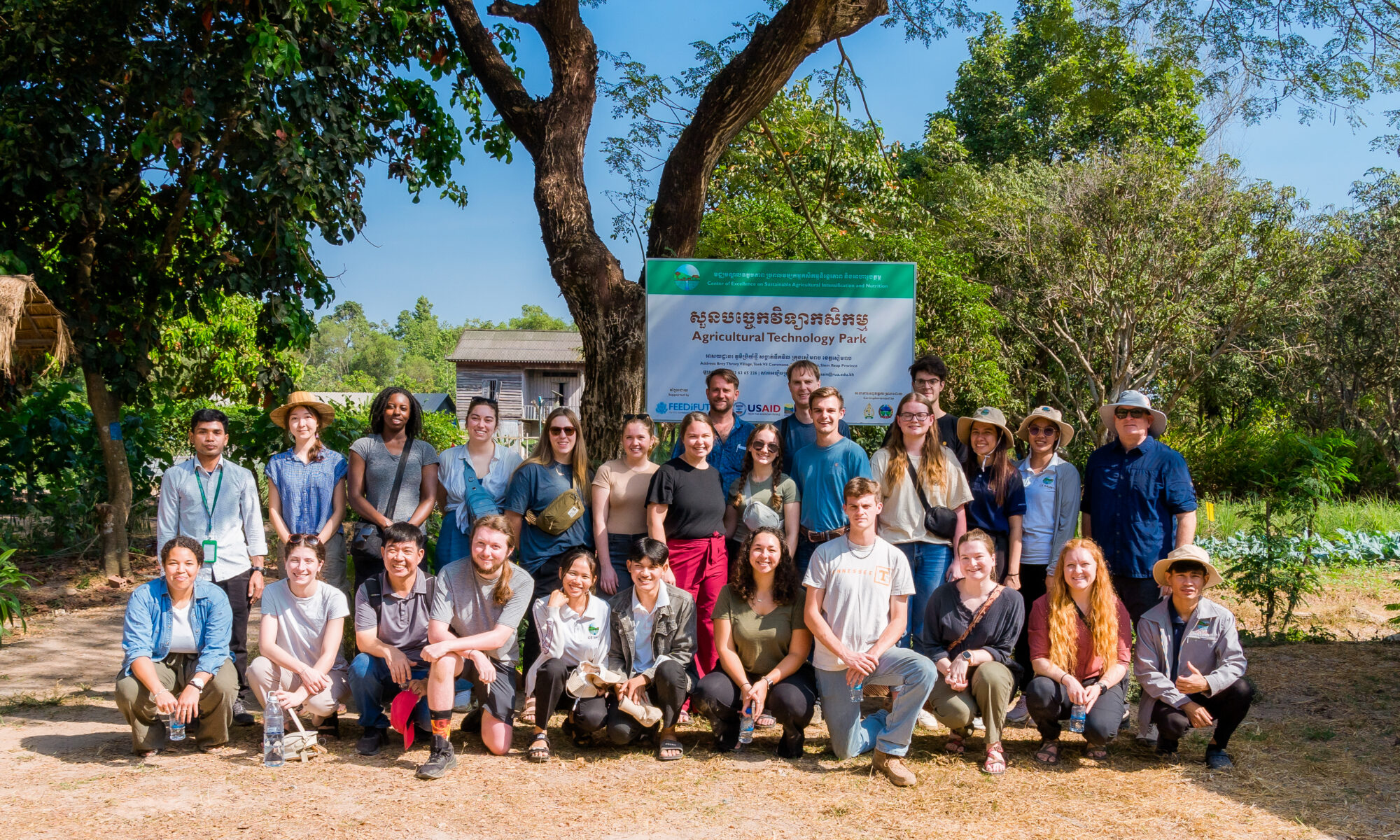
Nine University of Tennessee Knoxville students reflect on what they learned about global agriculture during a study abroad program in Cambodia in January 2024. Follow their journey through the photos they captured of moments that have changed the way they think about agriculture and natural resources not just here in Tennessee, but all around the world.
Alexa Sharp is a senior majoring in plant sciences. She chose to participate in the Cambodia program to understand the cultural impacts of injustice, gain experience with grassroots and academic efforts towards change and sustainability, develop respect for another culture, and gain experiential knowledge with another biome of plants.
Alexa’s Perspective: Trying such a large variety of food was a great experience that added to the exploration of agricultural traditions and emerging technologies within the country. One of the most impactful impressions was the variety of newer introduction crops such as corn, hydroponic lettuce, and cabbage being grown alongside more traditional crops such as Kampot pepper, rice, and lemongrass. It was great to see that many of the farms were growing various crops together, and incorporating soil health technologies like growing mung beans into the variety of crops.
I’ve included a photo of my favorite food-focused experience of the trip, which was trying some Kampot pepper ice cream in Battambang. The owner of KC Louge talked about the various ways he’s merging traditional ingredients with new culinary methods and Western flavors. These offer a new range of flavor combinations and products that bring traditional flavors like Kampot Pepper into emerging markets through diversification. That experience seemed to be a great way to sum up the agricultural shifts explored throughout the trip.
Bella Orr is a sophomore studying agriculture education. She hoped to expand her knowledge about international agriculture through traveling around Cambodia. She was also excited to learn more about both the education system and how they educate people about agriculture in Cambodia.
Bella’s Perspective: After visiting one of the schools, they talked about how net houses are new technological advances that students can bring home to their farms to prevent pests from destroying their crops. However, a net house is not “new” to Americans, rather it is pretty old technology. I would not even think of a net house when thinking about agricultural technology, instead I think about drones, tractors, machinery, and advanced irrigation systems. This made it sink in how American agriculture can be viewed as more advanced than agriculture in Cambodia. Manual labor is still a huge aspect of agriculture in Cambodia since machinery can be too expensive for farmers to afford.
I was surprised to see that almost every vendor at the market was selling the same few things—shrimp, octopus, squid, and fish. I did not understand how anyone could be making money from these products if they are all selling the same products right next to each other. However, when we learned that the vendors tend to share profits or encourage buyers to buy from other vendors, I was even more shocked. People would rather make less money and share the wealth than make more money and let other vendors suffer.
The differences in food safety practices at the markets shocked me. There was meat laying around everywhere without any refrigeration, instead the meat just laid outside all day long in the hot sun. Also, vendors did not wear gloves while cutting meat. This gave me a greater appreciation for all of the food safety measures that the U.S. has in place to keep us safe from food borne illnesses.
Callie Robinson is a sophomore majoring in agriculture and natural resource communications and minoring in international ag and ag leadership. The Cambodia program was her first time traveling abroad. She was excited to see the difference in food, culture, and lifestyle. She was also looking forward to learning about agriculture in a different country and climate.
Callie’s Perspective: Fencerows were one of the coolest thing that I learned about Cambodia agriculture, and I’ve shared about them with so many people since I’ve been home. They fold over live bushes to use as fences to save money. It showed me that Cambodian farmers really use all of their resources! And while this fence may not be as efficient as what we use in the U.S., it still gets the job done effectively.
Single axle tractors are really cool to look at, and seeing how they are used and relied on in countries like Cambodia is unreal. I realized how much I take advantage of the John Deere fleet on our own farm. These people work very hard for what they have, and find innovative ways to best use the technology they have.
The animals are also very different in Cambodia from Tennessee because they are adapted to the heat and receive different nutrition. It’s common practice to tie cattle up in one area and the Khmer people just sell them if they need some extra cash. It’s almost like having a live investment!
Campbell Emerson is freshman studying agriculture education. He was excited to see how agriculture is run outside of the U.S. By seeing and being a part of agriculture in a different country, he hoped to grow his understanding of agricultural education and its importance around the world.
Campbell’s Perspective: Growing up, all I knew was agriculture in Tennessee. I never cared to take notice of the industry anywhere else, because I never thought it had anything to do with me. I was hesitant to go on this trip for that very reason, but I very quickly changed my mind. There is so much to learn and share in agriculture across the world! Seeing the process in Cambodia was eye opening, and knowing our college has some type of impact on that through the “Farmer-to-Farmer Program” is inspiring.
At a high school we visited we actually got to participate in the agriculture education students were doing there alongside them. I highlighted it because it was a time for me to grow connection with those students. The next photo is a pepper farm we saw one the first days on the trip. It was a really interesting full functioning farm in Cambodia. From pepper fields, to lemons trees, to an amazing composting set up, it was great to learn and see about the life of a farmer in Cambodia.
The last photo is the group of students willing to take on this study abroad. Being able to represent Herbert College of Agriculture with a great group of students was a big part of studying abroad for me. This group never stepped away from an activity, and never let a smile drop their faces. To me, that was the biggest part of this trip. A group of strangers bonding over world agriculture and how Herbert can be apart of those opportunities!
Graham Witherspoon is a junior majoring in ecology and evolutionary biology and minoring in international agriculture and natural resources. He chose to participate in the Cambodia program because he was interested in how agricultural practices there are affected by conservation efforts and local ecosystems.
Graham’s Perspective: Before we left Knoxville, we learned about how Cambodians invest money in cattle rather than storing it in a bank, and that caring for them is not typically a top priority, but I was still a little shocked to see a lot of skinny cattle once we were there. I think the way Cambodians use cattle really serves to illuminate how limited a Cambodian’s access is to services and technology that we take for granted here. These cattle looked pretty healthy compared to a lot of the others we saw.
We also visited a silkworm hatchery and garment factory. It would have been difficult for me to come up with “silkworms” if you had asked me to name all the livestock I could think of before going to Cambodia. I think it’s easy to forget that ecosystems vary so incredibly across the planet and that folks may make use of species that you are hardly even aware of. I was incredibly impressed by the work of the seamstresses. I’m glad to see that passing a skill down over generations has enabled them to earn a living, although I’m aware that their work is, like raising other livestock, dependent on climatic conditions remaining favorable for the silkworms.
I feel like this photo of the hydroponic system at the Bantaey Meanchey office is a good example of the effort NGOs are making to educate Cambodian farmers on novel agricultural practices. I personally feel like there is no better way to learn than by doing or at least seeing something for myself, and a real construction of a hydroponics system like this may be the only way that a Cambodian farmer could actually learn a new practice. I’m glad that I saw it because it definitely painted a clear picture of the kind of informative models that can be provided in areas with limited information access.
Joao De Sa Filho is a senior majoring in biosystems engineering. He is passionate about learning about other cultures, expanding his horizons, and learning more about humanity in different places. Not only that, but he also have a personal goal of helping and working on urban agricultural systems and educating people on techniques that can be used to include low scale agriculture into their lives in ways that can be enriching and beneficial from a mental and physical health standpoint.
Joao’s Perspective: This winter mini term, I was lucky to be a part of the first UT sponsored Cambodia study abroad trip. In this two-week program led by the Smith Center, a group of students and I were introduced to Cambodian culture and lifestyle with an itinerary that was packed with activities that one by one brought us closer to understanding a different culture and how UTIA’s extension program is helping the country have more useful and applied information distributed to people in meaningful ways.
The hydroponic system shown was built with only information that was available online, by people who had never done this before, using a low budget in a country where dedicated materials are not available even with a high budget. Despite these challenges and complications, their team was able to build a system and develop techniques that as seen above yielded very high quality plants. Using these plants, they were able to sell them to the local community and provide a unique type of produce to people around them. While at UT we often learn the technical facts and know how on the workings of these systems, it is different to see it applied in real life. Not only that, but it was also unique to see this done in a small scale.
This is a vermiculture pit it is used to produce worm castings used to fertilize plants by giving the worms a favorable environment to produce said fertilizer. It was really interesting to learn how they move the worms around using a food incentive and harvest the castings when the worms have been moved out of an area, allowing them to take what they need out of it while leaving the worms alone to produce more in the future. Seeing this component of the farm was interesting since it displayed a well built and working alternate form to deal with a need the farmers had.
The visit to silk island involved a tour and presentation on how silk is made. This particular experience was important and relevant because while we were in Cambodia to see efforts to share about agricultural technology, this silk making process is one where people in Cambodia already had the knowledge on how to perform skillfully. Through this entire visit in Cambodia, it was interesting to see things get produced from scratch out of natural items. This is just not something that we are able to see happening often in the US. The silk island visit was probably the most intricate of the productions seen, including numerous steps in order to go from silk worm cocoons to fine silk scarves
Katie Collins is a sophomore who studies food and agriculture business from Charlotte, TN. She was most excited to see all the religious temples and try new food. She was also excited to learn about Cambodian culture from the students.
Katie’s Perspective: The market is something that stood out to me the most. The variety of products was numerous, but the range of the businesses was small. Within ten feet of each other people were selling the same products. I am a business major so making a business profitable is something that I was looking at when in the market. The market made me think that nobody really did anything from a business standpoint to make themselves any different. After talking with Dr. Ader, he told me that it is a cultural thing not to stand out. I was wondering if there was any way to help people make their products different like adding value to just raw products.
At this village farm, two things stood out to me. The mango tree was the first thing because of the boom-and-bust crops. The mango tree was producing great; however, they were not worth anything. It was a good indication that people don’t fully understand how markets work. They see someone making money then they all do it, then the crop is useless in a few years. The next thing that stood out was the infrastructure to get to the village. The roads were not great at all, and it shows that they have different challenges than we do. When we talk about how to address issues in a country like Cambodia, I think we must look at the bigger picture like roads, cultural traditions, and knowledge.
Hydroponics is something else that stood out to me. It was interesting that they learned about it from the internet, and the fact that it was very successful in growing lettuce. When the farmer pulled out the fertilizer that he put into the hydroponics system, he had no idea what he was putting in there. He didn’t really understand if it was what his plants needed or really what it was at all. This is vastly different from what would happen on a farm in the states.
Maddie Ashburn is a senior studying animal science, with minors in international agriculture and natural resources and leadership studies (honors). She was excited to learn about a different culture and to see the agricultural industry in another country first-hand.
Maddie’s Perspective: We saw these cows in a village we visited. I believe that these are Brahman cattle. I did some research and learned that the cattle breeds that are represented in Cambodia are the Kor Khmer, Hariana, and Brahman. This stood out to me because it relates to my major, animal science. We also learned that in this village someone bought a bull and charged the neighbors ten dollars for the bull to be with the cows, regardless of whether their cow got pregnant or not.
We visited this school garden in Battambang. This stood out to me because we learned about some of the challenges that were associated with this garden. Some challenges were that there was no one to maintain the garden when schools are out, there was a lack of knowledge, and finding a way to connect to the community outside of the school was difficult. There was also trouble with transportation of goods and no exchange of information.
The last picture was taken at the seed lab at the National University of Battambang. Learning about their seed lab was really interesting to me! One of the challenges that they had with the seed lab was pests. This picture relates to me because I work in a lab for the UT Beef and Forage Center. While I mainly work with forage samples, there have been seeds that I have worked with. I thought it was interesting to learn how a similar lab works in another country.
Noah Smith is from Washington County, Virginia and is currently a sophomore majoring in agricultural leadership. He has a double minor, one in animal science and one in political science. He was excited to travel to Cambodia to see a part of the world that he had never been to before and learn about the agriculture tactics that the country uses to be successful.
Noah’s Perspective: This is a picture from the market in Kep at the Crab Market. Like all the markets we saw, it amazed me how little food safety precautions were being used. As we discussed on the trip, there is not a lot of knowledge about food safety or sanitary measures. This makes it easy for contamination and food-borne illnesses to occur. I would like to one day see aid and funding go toward teaching safer food practices in order for there to be less of a fear of these dangerous illnesses. As an agricultural leadership major, I feel that there needs to be more awareness of this problem in order for there to be ways to make it safer.
This picture was taken at the first ATP we stopped at. To see the ongoing research there firsthand was very eye opening, and it was really amazing to me. I work at the East Tennessee AgResearch and Educational Centers and to be able to see similarities between the research I help with and the research in Cambodia is remarkable. I really enjoyed the opportunity to see how these findings were helping the community create a better agricultural environment. This is something that is really interesting to me and I would love to be able to keep up with the research and learn about the new findings they come up with.
This was at the MOU signing. To see the collaboration between the University of Tennessee Institute of Agriculture, USAID, and the Royal University of Agriculture was really interesting. This made me humble and proud that I attend a university that not only achieves the land grant model in the United States, but internationally as well. This was probably the most exciting experience of the trip as this is something that I want to do in my career. Seeing agriculture flourish around the world is the only way that society will be able to keep up with the growing world population. This partnership and others are the way that the U.S. can continue to improve the international agriculture industry. I feel there needs to be more attention to these partnerships and programs such as the Farmer-to-Farmer program.
